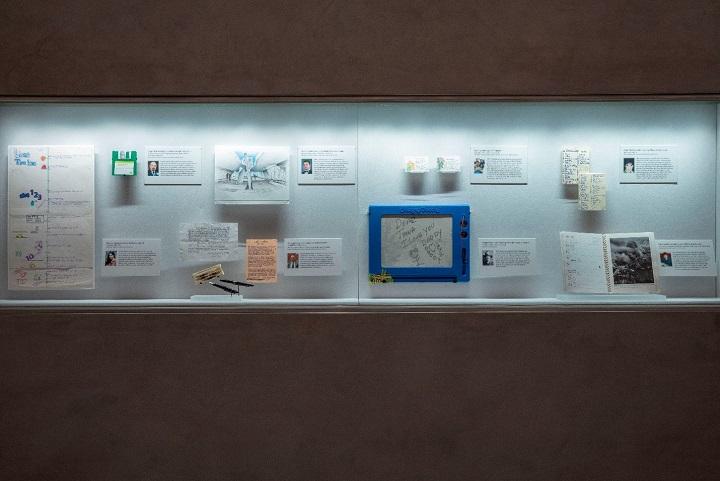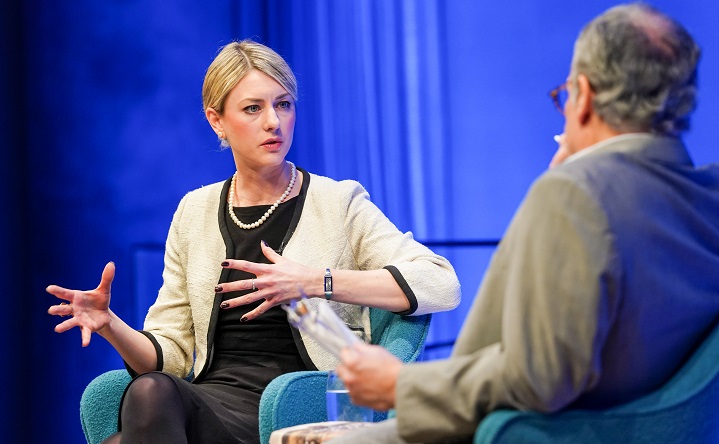On View: John August Santore's Magna Doodle Message
On View: John August Santore's Magna Doodle Message

The memorial exhibition serves as a space of reflection and remembrance to the victims of the 9/11 and the February 26, 1993 World Trade Center attacks. Each year we exhibit a selection of victims’ personal artifacts to help tell their unique stories to Museum visitors. The objects now on display speak to one of the most human and intimate forms of communication: handwriting.
One artifact that presented an interesting conservation challenge is a Magna Doodle loaned to the Museum by Tiana Santore. Tiana’s father, John August Santore of FDNY Ladder 5, responded to the attacks on the World Trade Center in 1993 and in 2001, when he died in the line of duty. Known for his doodles and notes, he frequently decorated his daughters’ lunch bags with charming messages and simple drawings—gestures of his deep affection. When cleaning out the basement of her childhood home on Staten Island in 2002, Tiana found one of his notes written on a Magna Doodle. Overjoyed that his “I love you” message had been preserved, she affixed yellow tape to the sliding bar on the lower left corner to prevent the words from being accidentally erased.

Tiana loaned the Museum this cherished object for display in the memorial exhibition. We knew we needed to carefully consider the display of the artifact to protect the integrity of the magnetic drawing material, which is mostly used to create ephemeral sketches, and is not a medium for which preservation is intended.
Evaluating the impact of a display or storage environment on a given material is an important part of a conservator’s work in a museum setting. We studied the Magna Doodle to learn more about the makeup of each component and its vulnerabilities. The toy is made up of several parts: a magnetophoretic writing display, a honeycomb structure beneath the display, and a polyethylene plastic frame. The writing surface is a clear plastic sheet with a honeycomb structure underneath that holds a thick, opaque liquid filled with tiny magnetic particles. When a magnet, like the one at the tip of the stylus, is applied to the surface of the toy, the magnetophoretic particles are drawn up and stay elevated in the thick liquid. The honeycomb structure then ensures that the magnetic particles are evenly distributed throughout the entire surface.
Although they may seem to last forever, plastics do degrade over time. We looked for signs of any embrittlement or crazing (tiny, hairline cracks over the surface), which would indicate a deterioration of the polyethylene. This deterioration can happen from exposure to UV light or even oxygen in the air. Thankfully, the Magna Doodle from Tiana was in excellent condition. We also examined the areas where the round magnets were stored and noticed small spots of corrosion on the bare metal. The corrosion was not active and is probably the result of moisture being trapped in between the magnets and the metal when the round magnets were still part of the toy. The missing magnets and drawing stylus are further evidence of a well-loved toy, so we chose to not replace them.
Most of all we scrutinized the writing on the toy’s surface, which made this artifact so special to Tiana and her family. Since the toy was designed to be kept flat and had been stored that way for years, we considered the impact of displaying it vertically—would the writing run or become blurry? Although the iron particles, suspended in a thick liquid, were designed to be unaffected by gravity, we wanted to be sure they would tolerate being upright and remain unchanged for more than a year.
We turned to Ebay to help answer these questions. A few clicks later and we were the proud owners of our very own vintage Magna Doodle. The newly acquired toy was of a similar age and had similar condition issues to the one we wanted to display. This included gray hazing in some areas and breaks in the honeycomb substructure.

Our colleague, Curator Alexandra Drakakis, assisted us by adding a message that covered all areas of the board. We wanted to have data from both the undamaged and damaged areas. Then in late October (National Cat Day is October 29), we photographed our own board and installed it vertically in our lab. This presented conditions that approximated what the drawing board would encounter in the gallery.
Left: Detail image of the cat in October 2017. Right: Detail image of the cat in June 2019.
Over the next 15 months, we monitored the text and kept an eye on the writing to make sure there were no changes. We photographed and compared the toy at various intervals and used overlays to ensure nothing was shifting. After the lengthy testing, we felt assured that Tiana’s Magna Doodle was safe to be displayed. We are thankful to her and her family that we’re able to share this sweet memory of her father, John August Santore, with visitors of the 9/11 Memorial & Museum.

By Maureen C. Merrigan, Assistant Conservator, 9/11 Memorial Museum
Previous Post
Visitors to Museum Meet Working Dogs, Celebrate Opening of "K-9 Courage"
On Saturday, February 1, the 9/11 Memorial Museum celebrated the opening of the new special exhibition, K-9 Courage, with a family-friendly K-9 festival.
Next Post
Counterterrorism Scholar Explains Essential Role of Women in Political Violence

On Monday, Joana Cook spoke about her research, her experience of 9/11, and the role of women in modern counterterrorism efforts in a public program at the 9/11 Memorial Museum.

